Abstract
A stacking sequence optimization method, which is conducted on the basis of a ground laminate and utilizes a two-level approximation as well as a genetic algorithm (GA), was developed before by the authors. Compared with general GAs, this method shows lower computational costs while reaching a high level of practical feasibility. However, the published work did not involve problems constrained with a strength requirement, which is essential for laminate structures subject to multiple loading conditions. Thus, in the present study, this approach is extended to implement strength constraints for laminate stacking sequence optimizations. First, to avoid the selection of some control parameters in the GA as well as to improve its performance, the standard genetic algorithm is modified with adaptive schemes in the fitness function and GA operators. Furthermore, by adopting the first-ply failure criterion and considering the stresses/strains for each layer in the ground laminate, the concept of temporal deletion techniques is proposed to extend this approach for handling optimization problems with strength constraints. Moreover, by combining the optimizer with the general finite element software MSC. Patran/Nastran, an optimization framework is established to conduct the optimization easily. Numerical examples are performed in repeated runs to illustrate the performance of the modified approaches in the GA as well as the feasibility and efficiency of this optimization system.








Similar content being viewed by others
References
Aymericha F, Serrab M (2008) Optimization of laminate stacking sequence for maximum buckling load using the Ant Colony Optimization (ACO) metaheuristic. Compos A: Appl Sci Manuf 39(2):262–272
Barbosa HJ, Lemonge AC (2003) A new adaptive penalty scheme for genetic algorithms. Inf Sci 156(3–4):215–251
Bruyneel M (2006) A general and effective approach for the optimal design of fiber reinforced composite structures. Compos Sci Technol 66(10):1303–1314
Chen S, Lin Z, An H, Huang H, Kong C (2013) Stacking sequence optimization with genetic algorithm using a two-level approximation. Struct Multidiscip Optim 48(4):795–805
Cho M, Rhee SY (2003) Layup optimization considering free-edge strength and bounded uncertainty of material properties. AIAA J 41(11):2274–2282
Fukunaga H, Chou T-W (1988) On laminate configurations for simultaneous failure. J Compos Mater 22(3):271–286
Gürdal Z, Haftka RT, Hajela P (1999) Design and optimization of laminated composite materials. Wiley, New York
Gantovnik VB, Gürdal Z, Watson LT (2002) A genetic algorithm with memory for optimal design of laminated sandwich composite panels. Compos Struct 58(4):513–520
Ghiasi H, Pasini D, Lessard L (2009) Optimum stacking sequence design of composite materials Part I: constant stiffness design. Compos Struct 90(1):1–11
Irisarri F-X, Abdalla MM, Gürdal Z (2011) Improved Shepard’s method for the optimization of composite structures. AIAA J 49(12):2726–2736
Kerea P, Lylyb M, Koskia J (2003) Using multicriterion optimization for strength design of composite laminates. Compos Struct 62(3–4):329–333
Kogiso N, Watson LT, Gürdal Z, Haftka RT (1994) Genetic algorithms with local improvement for composite laminate design. Struct Optim 7(4):207–218
Le Riche R, Haftka RT (1993) Optimization of laminate stacking sequence for buckling load maximization by genetic algorithm. AIAA J 31(5):951–956
Le Riche R, Haftka RT (1995) Improved genetic algorithm for minimum thickness composite laminate design. Compos Eng 5(2):143–161
Li D, Chen S, Huang H (2014) Improved genetic algorithm with two-level approximation for truss topology optimization. Struct Multidiscip Optim 49(5):795–814
Liu B, Haftka RT, Akgün MA (1998) Composite wing structural optimization using genetic algorithms and response surfaces. In: Proceedings of the 7th AIAA/USAF/NASA/ISSMO Symposium on Multidisciplinary Analysis and Optimization, Saint Louis, MO, 1–12
Liu B, Haftka RT, Akgün MA, Todoroki A (2000) Permutation genetic algorithm for stacking sequence design of composite laminates. Comput Methods Appl Mech Eng 186(2–4):357–372
Liu X, Cheng G, Yan J, Jiang L (2012) Singular optimum topology of skeletal structures with frequency constraints by AGGA. Struct Multidiscip Optim 45(3):451–466
Nagendra S, Jestin D, Gürdal Z, Haftka RT, Watson LT (1996) Improved genetic algorithm for the design of stiffened composite panels. Comput Struct 58(3):543–555
Park CH, Lee WI, Han WS, Vautrin A (2008) Improved genetic algorithm for multidisciplinary optimization of composite laminates. Comput Struct 86(19–20):1894–1903
Park J, Hwang J, Lee C, Hwang W (2001) Stacking sequence design of composite laminates for maximum strength using genetic algorithms. Compos Struct 52(2):217–231
Ren Z-W, San Y (2006) Improved adaptive genetic algorithm and its application research in parameter identification. J Syst Simul 18(1):41–43
Shakeri M, Yas M, Gol MG (2005) Optimal stacking sequence of laminated cylindrical shells using genetic algorithm. Mech Adv Mater Struct 12(4):305–312
Soremekun G, Gürdal Z, Haftka RT, Watson LT (1996) Improving genetic algorithm efficiency and reliability in the design and optimization of composite structures. In: 6th AIAA/NASA/ISSMO Symposium on Multidisciplinary Analysis and Optimization, Bellevue, WA, 372–383
Soremekun G, Gürdal Z, Haftka RT, Watson LT (2001) Composite laminate design optimization by genetic algorithm with generalized elitist selection. Comput Struct 79(2):131–143
Srinivas M, Patnaik LM (1994) Adaptive probabilities of crossover and mutation in genetic algorithms. IEEE Trans Syst Man Cybern Syst Hum 24(4):656–667
Todoroki A, Ishikawa T (2004) Design of experiments for stacking sequence optimizations with genetic algorithm using response surface approximation. Compos Struct 64(3–4):349–357
Todoroki A, Sekishiro M (2007) New iteration fractal branch and bound method for stacking sequence optimizations of multiple laminates. Compos Struct 81(3):419–426
Todoroki A, Sekishiro M (2008) Stacking sequence optimization to maximize the buckling load of blade-stiffened panels with strength constraints using the iterative fractal branch and bound method. Compos Part B 39(5):842–850
Acknowledgments
This research work is supported by the National Natural Science Foundation of China (Grant No. 11102009), which the authors gratefully acknowledge.
Author information
Authors and Affiliations
Corresponding author
Rights and permissions
About this article
Cite this article
An, H., Chen, S. & Huang, H. Laminate stacking sequence optimization with strength constraints using two-level approximations and adaptive genetic algorithm. Struct Multidisc Optim 51, 903–918 (2015). https://doi.org/10.1007/s00158-014-1181-0
Received:
Revised:
Accepted:
Published:
Issue Date:
DOI: https://doi.org/10.1007/s00158-014-1181-0




